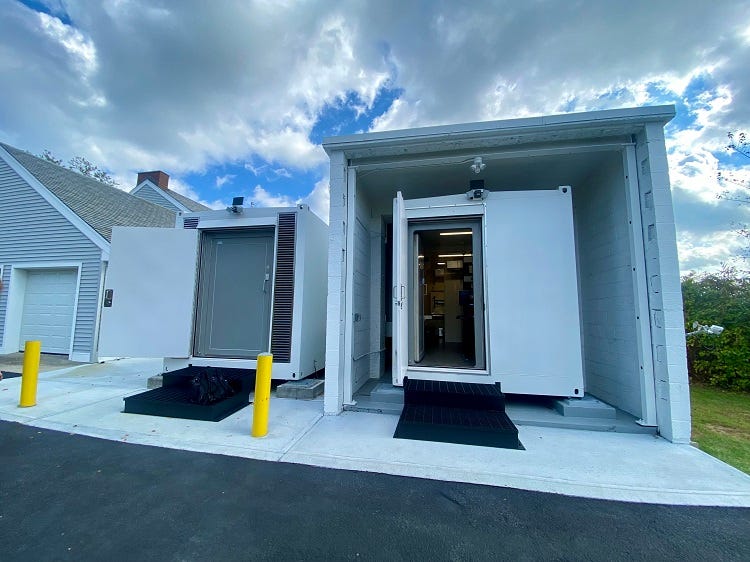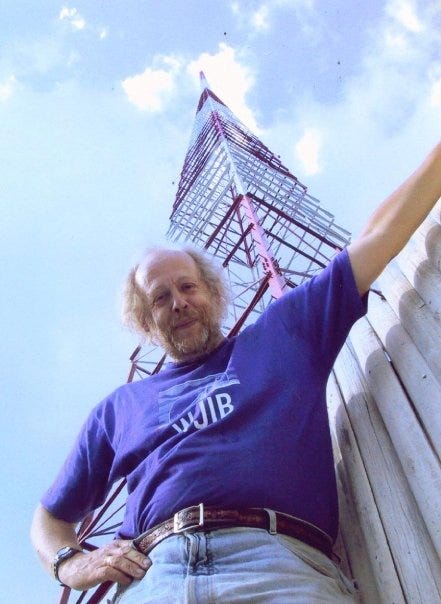Maybe you think it’s only traffic and weather together, but my local AM radio news station – WBZ Boston – is one of seventy-seven “Primary Entry Point” (PEP) sources that the US government has determined could reach 90 percent of the population in times of emergency. Toward that end, the Federal Emergency Management Agency (FEMA) has equipped WBZ with an “all hazards shelter.”
“The shelter includes a generator with a 60,000-gallon fuel tank and a separate studio that can be occupied for up to 60 days. It has been hardened to remain usable in the presence of chemical, biological and nuclear hazards,” reported RadioWorld in October 2021.
Come what may, we’re going to get traffic and weather for up to 60 days post-apocalypse.
Or maybe the DJ inside that shelter, hardened against whatever chemical, biological or nuclear hazards are decimating the rest of us, will switch formats? There won’t be any meetings with corporate to come, after all; no audience share reports, or advertisers to please. In which case, I would like to imagine they might just play their favorite music instead of all those gloomy emergency bulletins. Like AM radio DJ Bob Bittner did on the station he owned in Cambridge, WJIB, until his sudden death last month.
Bob Bittner was the only DJ on WJIB, and he played only records from his own collection. As he told me in 2017 (in an interview conducted for my podcast Ways of Hearing, but unfortunately left on the cutting room floor), the core of that collection came from the reject pile at a “progressive rock” station he worked for in the early 1970s, WCMF in Rochester NY. “All the demonstration copies they got from record companies… I was there to rescue them before they got thrown away. Boxes and boxes of promotional singles” too unhip for the station to care about. But Bob “always loved melodious music. I never cared for progressive rock. I worked at that station because it was a big jump in my career,” he explained.
After many years pursuing that career, including a stint at several Boston stations such as WBOS at the height of its disco phase – which must have yielded a particularly rich reject pile - Bob Bittner bought his own AM station at a bankruptcy auction in 1991, and took it over as a kind of retirement project.
And then the rejected records started coming to his door.
“You know some people are downsizing after the kids are gone, or they move away, whatever. Sometimes a more elderly couple doesn’t need to have a big house - they might get a smaller one cause it's easier to take care of. What are the first things to go? Records. What's the first place they call? The radio station that plays those records. Throughout the last 25 years I've got so many donations of records, that's what 90 percent of my record library is - from donations.”
As his own boss, “I violate every rule in the radio rulebook. I really do,” he told me. “I play what I want.” Not that the station was “freeform” – a format Bob knew well from his early years in the FM radio world. Instead, Bittner developed his own version of a station playlist, mandating groups of songs to be included for certain percentages of air time.
“It's not all my personal taste because I play songs I don't like,” he told me. “You have to. If I played only songs that I liked then I would be limiting my playlist down to about 60 percent of what it is.”
I asked him to elaborate.
Q: So you mentioned a theory about how to put how to put the playlist together, can you tell me more about that.
A: Yeah. I have about 44, 45 categories of music in the computer and they all rotate at different speeds. So therefore you don't usually - or you don't ever really - hear the same song after another song. The computer selects two different speeds according to my programming. Now let's say 44 categories - I have 11 categories that rotate at four different speeds. Let's say my A category is music from ’55 through 1969. It's just the core of my music on the station. There are four different rotations depending on how good I think the song is from that time period.
Then I have another category - the B’s. The B category is for big band instrumentals - and there are four different rotations for how good they are.
And then there are songs that I really don't want to hear ever again. But I have to because they were big hits.
Q: So why do you think it's important to include the hits that you don't like - because other people do like it?
A: I’m not playing music for myself. I'm doing the best that I can to play music that pleases lots of people.
Bob Bittner’s playlist of rejected records, ranked according to his own taste plus the taste of others – based on old lists of the hit parade – did please lots of people. Over time, he added several more stations to extend the reach of his broadcasts up and down the New England coast, and he kept all of them on the air purely through voluntary donations from listeners. There were no ads, and as he made clear each year during his annual on-air fundraisers, the stations were not non-profit so there wasn’t even the promise of a tax deduction.
And there never was a second DJ. Bob Bittner kept his stations on 24/7 using a system of VHS tapes that could play his record collection even when he wasn’t in the booth, and this constantly shifting kaleidoscope of near hits, non-hits, and hits you don’t ever want to hear again (as Bob put it) was mesmerizing. A Facebook group of fans developed spontaneously that revealed a wide range of ages and uses for this broadcast.
For me, WJIB was best at night – especially summer nights, outside, on a transistor radio.
Q: I get it on my AM transistor radio - it sounds amazing.
A: Ooh, a transistor radio. Good.
Q: Well I live just a few blocks from your tower. So I get fantastic reception actually, especially at night. I know you have to cut the power at night, right?
A: Yes. But there's so much less interference. So it can come in really crystal clear at night.
The power has to be cut for WJIB at night to make way for a Canadian station on the same frequency – part of the elaborate system developed over the 20th century for regulating broadcasts on our shared airwaves. Regulation that also provides the emergency governmental network anchored to those seventy-seven “Primary Entry Point” stations.
But the interference that Bob Bittner mentioned to me isn’t from other AM stations – it is from other electronic devices, more of which are simply on during the day than at night. Computers; computer monitors; halogen lights; dimmer switches; anything and everything with a motor… the list is long, and the distribution of these devices is getting more and more dense all the time. AM is so sensitive to disruption, the Federal Communications Commission (FCC) recommends it as a kind of divining rod for electrical interference in general:
“A simple method of determining the location of electrical interference is by using a portable battery-powered AM radio tuned to a quiet frequency at the lower end of the dial. You should hear static or a buzzing sound as you get close to the source of the interference. The closer you get, the more intense the static will be.”
Possible sources in one’s home, the FCC suggests, may include “hair dryers, sewing machines, electric drills, doorbell transformers, light switches, smartphone chargers, power supplies, computing devices, washing machines, clothes dryers, fluorescent lights, LED lights, or garage door openers.”
And then there are electric cars. Electric cars create such strong interference that many manufacturers have stopped including AM in their factory sound systems, because the car itself prevents reception. Tesla – surprise! – was the first automaker to drop AM from its products. Others have followed.
This has sparked concern at a governmental level, in part because of the emergency network that FEMA tries to protect even through extreme disaster. Senator Ed Markey, from here in Massachusetts – I wonder if he has ever tuned in to WJIB? – recently introduced the “AM for Every Vehicle Act,” requiring electric car makers to include AM in their vehicles and do what they must to make it work in them. And even in these contentious times, this is a bipartisan bill, truly – it is cosponsored by none other than Sen. Ted Cruz of Texas. (Did he study for his law exams at Harvard while tuned in to WJIB…?)
But whether or not Sen. Markey’s efforts succeed in forcing Elon Musk and others to include AM radio in their cars, rescuing AM from the fast-increasing electronic interference at large seems quixotic. As is a station run by a lone DJ. Thank you Bob Bittner, from one of your many devoted Sancho Panza listeners. May his memory be a blessing.
Listening to: Archangel Hill by Shirley Collins
Cooking: Ceviche at Holbox LA (a restaurant meal – back on the road!)






Oh no! I love WJIB. How sad, I had no idea he died. We moved to Cambridge in late 2015 and discovered the station shortly after...I wonder if we found it after it started on FM in 2017. We can see the radio tower from our apartment. It was a wonderful local oddity, fewer of which seem to be around these days. WJIB definitely made the world a cozier place.